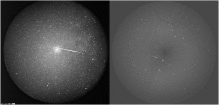Activity profile, mass distribution index, radiants, and orbits of the 2018 Draconid meteor shower outburst
Abstract
An outburst of Draconid meteor shower was predicted for October 8 to 9, 2018. Using a variety of video and photographic cameras covering a broad range of magnitudes, the shower activity profile was measured. The main peak was observed at the solar longitude λo =195.359∘ ±0.003∘ , what is equivalent to 23h07 . 5 m ±5m UT. This result is in good agreement with other reports as well as with the predictions. Two other sub-peaks or enhancements of the activity were detected later in the night. The maximum flux of meteoroids reached value of Φ6.5 = 0.033 ± 0.007 meteoroids km-2 h-1 [MV> +6.5]. This is equivalent to ZHR = 140 ± 30 which is higher than the majority of the models predicted. The analysis of the mass distribution index evolution and the comparison with other experiments suggests that the later activity was probably caused by the mixture of the different trails of the stream which were more dispersed. The flux of the meteoroids was three to four times smaller in comparison with the 2011 Draconid outburst. When comparing the radiants and velocities of the observed meteors with the model data, good agreement was found for the right ascension and velocity but a small offset of about +0.5∘ was observed in declination. On the other hand, the mean main peak radiant fits well the model of Maslov (2011).
- Publication:
-
Planetary and Space Science
- Pub Date:
- May 2020
- DOI:
- 10.1016/j.pss.2020.104871
- Bibcode:
- 2020P&SS..18404871K
- Keywords:
-
- Meteors;
- Meteor showers;
- Draconids
